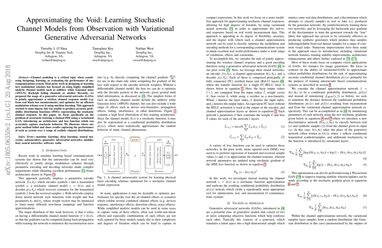Approximating the Void: Learning Stochastic Channel Models from Observation with Variational Generative Adversarial Networks
Channel modeling is a critical topic when considering designing, learning, or evaluating the performance of any communications system. Most prior work in designing or learning new modulation schemes has focused on using highly simplified analytic channel models such as additive white Gaussian noise (AWGN), Rayleigh fading channels or similar. Recently, we proposed the usage of a generative adversarial networks (GANs) to jointly approximate a wireless channel response model (e.g. from real black box measurements) and optimize for an efficient modulation scheme over it using machine learning. This approach worked to some degree, but was unable to produce accurate probability distribution functions (PDFs) representing the stochastic channel response. In this paper, we focus specifically on the problem of accurately learning a channel PDF using a variational GAN, introducing an architecture and loss function which can accurately capture stochastic behavior. We illustrate where our prior method failed and share results capturing the performance of such as system over a range of realistic channel distributions.
PDF Abstract